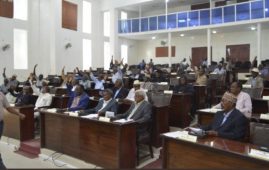EXECUTIVE SUMMARY
Kenya is a republic with an institutionally strong president and a prime minister with unclearly defined executive powers. There is a unicameral national assembly. In 2010 citizens approved a new constitution in a national referendum, widely considered to be free and fair. The new constitution includes significant institutional and structural changes to the government, including the transition to a bicameral legislature, the abolition of the post of prime minister, and the devolution of fiscal and administrative authority from the central government to 47 newly created county governments. The new constitution stipulates the creation of a Supreme Court, which was established in June 2011. In 2007 the government held local, parliamentary, and presidential elections. Observers judged the parliamentary and local elections to be generally free and fair. In the presidential election, incumbent Mwai Kibaki was proclaimed the winner by a narrow margin under controversial circumstances. Serious irregularities undermined the integrity of the presidential election results. Raila Odinga, the main opposition candidate, disputed the results, and violence erupted in sections of Nairobi and opposition strongholds in the Nyanza, Rift Valley, Western, and Coast provinces. Approximately 1,150 persons were killed and more than 350,000 displaced by violence from December 2007 to February 2008. The two sides agreed to form a coalition government as a result of international mediation. Under the terms of the agreement, President Kibaki retained his office and Odinga was appointed to the newly created position of prime minister. The parties also agreed to undertake a series of constitutional, electoral, institutional, and land reforms to address underlying causes of the crisis. There were instances in which elements of the security forces acted independently of civilian control.
The most serious human rights problems were abuses by the security forces, including unlawful killings, forced disappearances, torture, rape, and use of excessive force; inter-ethnic violence; and widespread corruption and impunity throughout the government.
Other human rights problems included police corruption; harsh and life-threatening prison conditions; arbitrary arrest and detention; prolonged pretrial detention; some judicial corruption; arbitrary interference with the home and infringement on citizens’ privacy; restrictions on freedom of speech, press, and assembly; abuse and forced resettlement of internally displaced persons (IDPs); abuse of refugees, including killing and rape; abridgement of the right of citizens to change their government; violence and discrimination against women; violence against children, including female genital mutilation/cutting (FGM/C); child marriage and forced marriage; child prostitution; trafficking in persons; discrimination against persons with disabilities and albinism; discrimination based on ethnicity, sexual orientation, and HIV/AIDS status; violence against persons with HIV/AIDS; mob violence; lack of enforcement of workers’ rights; forced and bonded labor, including of children; and child labor.
Widespread impunity at all levels of government continued to be a serious problem, despite implementation of judicial reform and the vetting of all judges and magistrates. The government took only limited action against security forces suspected of unlawful killings, and impunity in cases of corruption was common. The government took action in some cases to prosecute officials who committed abuses and, for the first time, several former senior government officials were convicted of corruption. Nevertheless, impunity–particularly in connection with human rights abuses committed during the post-2007 election violence–was pervasive.
***********
Read the full text here – 2012 Human Rights Reports: Kenya (link)
Check the archives for related posts.





